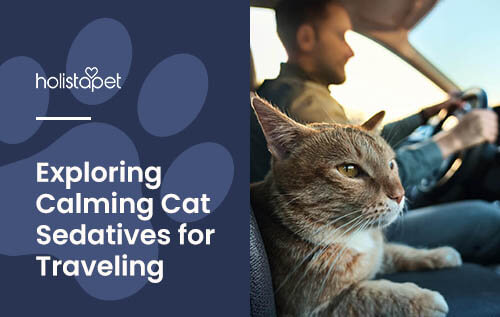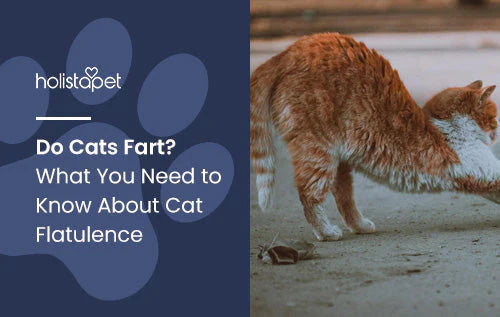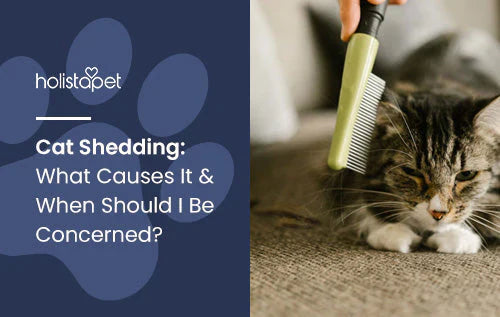Pet parents often wonder how they can help their cats feel calmer on the go. Natural cat sedatives for travel might do the trick. Travel sedatives can help fearful or jittery pets relax, whether it's a long road trip or a quick trip to the veterinary clinic.
Is your kitty afraid of car rides? In this post, we'll discuss how a quality cat sedative can help your feline friend during these stressful events.
Why Might Cats Need Sedatives for Travel
Car travel, or any form of travel, can be tough for cats. These events can trigger unpleasant feelings as felines naturally fear traveling. The unfamiliar sights, sounds, smells, and motions can stress them out.
With the calming effect of travel sedatives, journeys with your feline friend can be more comfortable. These options can help your cat feel calmer when they're out of the house and out of their comfort zone.
Understanding Travel Anxiety in Cats

Travel anxiety in cats is quite common. The strange environment, car engine roar, and sudden movements can all agitate felines. For many cats, this uneasiness can manifest physically and behaviorally.
Anxious pets may start panting, vocalizing, or attempting to escape their cat carrier. Sedatives may help prevent these issues and relax your kitty during the trip.
How Travel Can Affect Your Cat's Behavior
Traveling can cause cats to act out. Many cats become upset when placed in a car, feeling trapped and uncomfortable. These triggers can cause excessive meowing, scratching, and even aggression.
Some cats might experience physical symptoms, like trembling or changes in body temperature. You can help prevent these problems with cat sedatives.
Signs Your Cat May Need a Sedative for Travel
How your cat reacts during travel can give clues as to whether they need a sedative. Signs your pet may need one include:
- Excessive Vocalizing. Your cat may cry out loudly, expressing agitation or discomfort.
- Panting or Heavy Breathing. Cats sometimes pant when they're nervous.
- Attempting to Escape. If your cat continuously tries to escape their carrier, they may be feeling trapped.
- Trembling or Shaking. An overwhelmed or scared cat may start shaking.
- Aggression or Irritability. Cats may become aggressive when stressed.
What Are Cat Sedatives?
Cat sedatives are substances used to calm cats. They may help reduce anxiety and prevent agitation during stressful events.
Sedatives for cats come in various forms to meet the needs and preferences of each individual cat. You can find them in pill, liquid medication, spray, or treat forms. Some are prescription-based, while others are natural. Before trying out this pet remedy, get some veterinary advice first.
Types of Sedatives for Cats
Pet parents can choose from different types of cat sedatives. Different options include:
- Cat Melatonin. Supports healthy sleep patterns, promotes relaxation, and helps reduce agitation.
- CBD (Cannabidiol) for Cats. A natural remedy that brings calming effects without the sedative properties of traditional medications.
- Chamomile. Has a mild sedative effect that can help soothe anxious pets.
- Valerian Root. Has calming properties that can help reduce agitation.
- Catnip. Often has a calming effect after the initial reaction (excitement) wears off.
How Sedatives Work To Calm Cats
Sedatives work by slowing down your cat's central nervous system. These calming aids may ease tension in your pet's body, helping them feel relaxed and less reactive to triggers.
For most cats, sedatives can make them feel more comfortable and secure. Whether it's a natural or prescription sedative, in solid or liquid form, the goal is to help your kitty stay relaxed and stress-free.
Short-Term vs Long-Term Sedatives for Travel
When using a cat sedative for your furry friend, you must know the difference between short-term and long-term options. Keep these in mind:
- Short-Term Sedatives. Typically used for quick trips. These work quickly and wear off after a few hours. Your cat can return to their normal behavior once the trip ends.
- Long-Term Sedatives. Typically used for extended travel or multi-day trips. These have a longer-lasting effect and can help your cat feel calmer over a prolonged period.
Natural vs Prescription Cat Sedatives
Cat sedatives come in two main categories: natural and prescription. Here's how they differ:
- Natural Sedatives. Often include ingredients like melatonin, valerian root, or CBD. These provide a gentler approach to calming your cat without harsh chemicals. These are generally considered safe and well-tolerated by pets.
- Prescription Sedatives. Stronger sedatives are prescribed by vets for more severe cases. These medications may be more potent. They require careful dosage and may cause certain side effects.
Benefits of Natural Calming Aids for Cats

Natural calming aids can offer several advantages to cats. A natural pet remedy can help bring calm without the stronger effects of a prescription drug. Consider these benefits:
- Well-Tolerated. Natural options like CBD and chamomile are generally considered safe for most pets. They have fewer side effects compared to prescription sedatives.
- No Prescription Needed. You can easily access natural calming aids without a prescription. Of course, you still need to talk to your vet for guidance.
- Gentle On the Body. Natural remedies typically don't cause significant sedation. They can help your cat feel at ease without the heavy drowsiness associated with stronger sedatives.
Risks and Considerations for Prescription Sedatives
Prescription sedatives for cats are usually stronger than natural ones. So, they potentially can cause more obvious side effects like excessive drowsiness or disorientation. In some cases, cats may also experience vomiting or changes in heart rate.
Consult your veterinarian for specific medication recommendations. To avoid unwanted results, ensure the dosage is just right for your cat's weight and health condition.
What To Look for When Choosing Sedative Cat Products
You'll want to pick a sedative that's right for your cat. To do that, consider these factors:
- Key Ingredients. Look for calming ingredients like melatonin, CBD, or valerian root.
- Form Of the Sedative. Think about what form of supplement your cat will like.
- Natural vs Prescription. Depending on your pet's needs, a natural remedy may do, or you may need a stronger option.
- Dosage and Potency. The sedative's dosage and strength should suit your cat's size and needs.
- Safety. Choose cat-specific, vet-approved products that are generally safe for feline pets.
Key Ingredients To Look for in Calming Products
Certain ingredients can help relax our feline friends. Keep an eye out for these components:
- CBD for Cats. Offers calming effects without sedation.
- Cat Melatonin. Helps regulate sleep cycles and promotes relaxation.
- Chamomile. Has soothing properties that may help comfort anxious pets.
- Valerian Root. An herbal remedy that may help reduce agitation.
- Catnip. Has a relaxing effect after the excitement subsides.
- L-Theanine. An amino acid found in green tea that promotes relaxation without drowsiness.
- Tryptophan. An amino acid that helps produce serotonin to help regulate mood.
- Passionflower. A natural herb with mild sedative properties that can help calm nervous cats.
Fun fact: HolistaPet's calming cat supplements contain many of these beneficial ingredients. They all work together to help soothe anxious kitties during challenging situations.
Dosage and Potency Considerations

The correct amount of sedative can help cats receive calming benefits while avoiding unwanted effects. Always follow the recommended dosage on the label, or better yet, consult your veterinarian.
Potency may vary between natural and prescription options. Natural sedatives often require a higher dosage, but starting with a lower dose is best. You and your vet can adjust the amount based on your cat's response.
Natural vs Synthetic Options
You also have the choice between natural sedatives and synthetic sedatives. To understand their differences:
- Natural Sedatives. Often include ingredients like CBD, valerian root, or chamomile, which come from plants and herbs. These options are generally considered well-tolerated by pets.
- Synthetic Sedatives. Typically prescription-based and formulated with chemicals for stronger effects. While effective, they may carry a higher risk of side effects.
What Calming and Relaxing Cat Options Do We Offer?
At HolistaPet, we are proud to be the number one supplier nationwide of CBD pet supplements, including calming products for cats. You can choose from our:
- Calming CBD Oil for Cats. This easy-to-administer oil offers a fast-acting, soothing effect. It combines premium, broad-spectrum CBD (meaning there's no THC or tetrahydrocannabinol) and hemp seed oil to promote relaxation.
- Crunchy CBD Cat Treats. These treats combine CBD with a delicious crunch. Each salmon- or chicken-flavored treat contains broad-spectrum CBD, ensuring a positive experience without the mind-altering effects of THC.
- Cat CBD Soft Chews. These provide a gentle, soothing effect, ideal for pets that prefer a softer texture. Our CBD cat chews combine broad-spectrum CBD, valerian root, tryptophan, catnip, and taurine.
Why Choose HolistaPet for Pet Calming Aids?
HolistaPet stands out for providing high-quality, natural, and safe calming aids for pets. Here's why many customers choose us:
- Our Commitment to Natural and Safe Ingredients. We use only natural ingredients, ensuring your cat receives a well-tolerated and gentle product.
- Third-Party Lab Testing for Safety and Potency. All our products undergo rigorous third-party lab testing to assure safety and effectiveness.
- Customer Satisfaction and Success Stories. Our customers love our products, and many pet owners share their success stories on our website.
- Approved and Recommended by Leading Veterinarian Dr. Kwane Stewart. Our products are highly recommended by Dr. Kwane Stewart, HolistaPet's Chief Veterinary Officer, who has been a practicing vet for over 25 years.
- Great Deals and Savings. You can enjoy 25% off on your first order. Plus, take advantage of our membership, subscription, and bundle options for even more savings.
How To Administer Sedatives to Your Cat
Giving your cat a sedative can be easy if done correctly. Here's a step-by-step process to help:
- Prepare the Sedative. Have the product ready before approaching your cat, whether it's a chew or a spray.
- Secure Your Cat. Gently hold your pet in a comfortable, secure position to prevent them from escaping.
- Administer the Sedative. If using a pill, gently open your cat's mouth and place the pill towards the back of the tongue. For an easier option, try our soft chews.
- Offer Water or a Treat. After giving the sedative, offer your cat water or their favorite treat to help them swallow.
- Watch Your Cat. Observe your furry friend to ensure they react well to the sedative.
Best Practices for Giving Sedatives Before Travel
Giving cat sedatives before travel requires careful planning to ensure a smooth journey. Here are some best practices to follow:
- Give the Sedative Ahead of Time. Administer the sedative at least 30 minutes to an hour before travel to allow it to take effect.
- Use the Right Dose. Follow the recommended dosage to avoid unwanted effects.
- Create a Calm Environment. Reduce noise and movement to help your pet relax.
- Test the Sedative Beforehand. Try giving your cat the sedative in a non-stressful environment first to see how they react.
- Watch Your Cat's Response. After giving the sedative, observe your cat to see if they'll calm down or experience side effects.
Importance of Basing Dosage on Cat Size
Basing the dosage on your cat's size and weight can help the sedative work safely and effectively. A lower dose is usually enough for smaller cats or kittens, while larger cats may need a higher dosage. Always follow the dosage guidelines on the label and consult your veterinarian to determine the perfect amount for your pet.
Preparing Your Cat for a Calm and Safe Journey
To save your cat from worries during travel, prepare ahead. Here's a simple process to follow:
- Familiarize Your Cat With the Carrier. Before the trip, leave the carrier out for your cat to explore.
- Use Calming Aids in Advance. Give the sedative at least 30 minutes before the trip to let it take effect.
- Secure the Carrier. Ensure your cat's carrier is properly closed so your cat cannot escape.
- Keep a Calm Environment. Reduce loud noises and speak softly to your cat during the trip to maintain a soothing atmosphere.
- Observe Your Cat. Check your cat regularly to make sure they are comfortable and relaxed.
Are There Any Side Effects of Cat Sedatives?
Yes, cat sedatives may sometimes cause side effects, but they are generally mild and depend on the product used. Common side effects include drowsiness or dry mouth. These usually subside once the sedative wears off. If you notice any severe reactions, such as vomiting or extreme lethargy, consult your veterinarian immediately.
Common Side Effects To Be Aware of and Watch For
Although cat sedatives are widely regarded as safe, they can still cause side effects. Watch for the following:
- Drowsiness. Your cat may seem more tired than usual.
- Dry Mouth. Sedatives can cause a decrease in saliva production.
- Lethargy. Excessive lethargy could indicate an overdose.
- Vomiting. Stomach upset or vomiting may occur after taking a sedative.
- Changes in Appetite. Your cat may eat less or more than usual.
When to Contact Your Veterinarian
If your cat reacts poorly to a sedative, contact your vet immediately. Your pet may be sensitive to certain ingredients or have ingested too much of the product. Some red flags include:
- Excessive Vomiting or Diarrhea
- Unusual Behavior or Aggression
- Difficulty Breathing or Rapid Heart Rate
Final Thoughts on Cat Sedatives for Travel
No more jittery kitty during your next trip to the vet. With quality cat sedatives, your feline friend can remain calm and comfortable throughout the journey. Whether using natural remedies or prescription options, the goal is to reduce your cat's worries.
At HolistaPet, we offer a range of natural calming aids to help your pet feel more at ease. With our trusted and safe ingredients, your cat can experience a relaxing trip, making travel less stressful for both of you.







![Probiotics For Dogs [Soft Chews] - HolistaPet](http://www.holistapet.com/cdn/shop/files/Probiotic-Infographic-1_472d7a29-e30c-435a-9638-1365d8c3a9f9.jpg?v=1725384841&width=104)




























Leave a comment
All comments are moderated before being published.
This site is protected by hCaptcha and the hCaptcha Privacy Policy and Terms of Service apply.